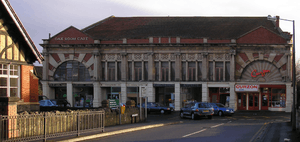Curzon Community Cinema, Clevedon
The Curzon Community Cinema, in Clevedon, North Somerset, England, is one of the oldest continually running purpose-built cinemas in the world.

Opened on 20 April 1912 by Victor Cox, the original building had 200 seats and the first show raised funds for the survivors and relatives of those killed earlier in the month on the RMS Titanic.[1][2][3] Its first projector was gas powered, but in subsequent years the building was improved with the addition of extra seating (bringing the total number of seats to 389), and was the first public building in the town to have electricity, which also saw the projector upgraded to run on electric.[4]
Between 1920 and 1922, a new cinema was built on the site (without interruption to the nightly programme of films). The building, still in use to this day, has a row of shops along the front, the Oak Room Cafe above, and facilities for stage shows. The cinema was the site of Clevedon's only fatality due to enemy action in the Second World War, when a soldier standing in the cinema doorway was killed by a bomb, damage from which is still visible on the exterior.[3] Muriel Williams, who was in the cinema when it was bombed, recalls the air raid warning flashing on the screen on the night it was bombed in the Curzon Memories App.[5] The App also includes memories from Julia Elton (daughter of documentarian Sir Arthur Elton, who remembers her grandmother frequenting the Oak Room Cafe and rephotography of archive photos of the cinema through the ages.
In 1945, the cinema (previously known as "The Picture House") was sold and changed its name to the "Maxime".[4] Another change of ownership in 1953 brought its current name. After years of decline, the building was greatly altered during the late sixties and early seventies: the box fronts, along with the organ, were removed and the openings 'bricked-up', the balcony was closed, the suspended false ceiling installed, and the projection room returned to its original position at the rear of the stalls.[6]
Never hugely profitable, the cinema was taken into administrative receivership in 1995, and after a campaign to save the cinema spearheaded by Jon Webber, it was bought by Clevedon Community Centre for the Arts, a registered charity, which continues to run it. Patrons include Sir Charles Elton (son of the notable documentary director Sir Arthur Elton), Aardman Animations founders David Sproxton and Peter Lord, directors Nick Park and Terry Gilliam, and actors Tony Robinson and Alan Rickman.[7]
In 2009, the Curzon Cinema successfully passed the first round in its bid to the Heritage Lottery Fund (HLF) and was awarded £31,700 to help develop a more detailed bid for second phase of the awards process.[8] A subsequent Stage II award of £321,900 in 2010 allowed the cinema to complete the first stage of restoration, with some repairs made to the roof, a new exhibition and lounge bar installed, and the Curzon Collection of Heritage Cinema Technology being relocated to the former Coach House adjoining the building.[9]
In 2012, the Curzon Cinema reached the final for Best Heritage Project of the National Lottery Awards.[10]
The Curzon celebrated its centenary on 20 April 2012, with a weekend of celebrations.[11] Run by charitable trust, the Curzon is now seeking to raise funds for the next phase of its restoration, including the Balcony.[12]
In 2015, the former Coach House was transformed into a cafe bar and the Curzon Cinema Collection was put on display throughout the cinema.
Run by a charitable trust, the Curzon is now seeking to raise funds to complete the restoration of the building, the interior tin panelling, the balcony and to install a second screen, creating a sustainable future.
From 2018, the Curzon began to host a boomsatsuma Media Production Extended Diploma[13] at the Curzon Cinema Studio, alongside the North Somerset Creative Campus at Nailsea School.
References
- "Curzon Community Cinema". Cinema Treasures. Retrieved 11 August 2018.
- "Picturehouse Perfect". The Colour of Money. Triodos Bank. Retrieved 11 August 2018.
- Crofts, Charlotte. "Technologies of seeing the past: The Curzon Memories App." (PDF). In Stuart, D.; Jonathan, P. B.; Kia, N. (eds.). Proceedings of EVA London 2011: Electronic Visualisation and the Arts. British Computer Society. ISBN 9781906124885.
- "Bristol — Coast — Curzon cinema". BBC. 21 June 2005. Retrieved 30 April 2009.
- "The Curzon Community Cinema, Clevedon: History". curzon.org.uk. Archived from the original on 21 July 2012. Retrieved 10 September 2012.
- Thornton, Maurice (2005). The Everlasting Picture Show. Clevedon: Curzon-Clevedon Community Centre for the Arts. p. 160. ISBN 978-0-9549962-0-8.
- "The Curzon Community Cinema, Clevedon: Patrons & Supporters". Curzon.org.uk. Archived from the original on 22 August 2017. Retrieved 22 August 2017.
- "The Curzon Community Cinema, Clevedon: Home Page". Curzon.org.uk. Archived from the original on 20 April 2009. Retrieved 30 April 2009.
- "The Curzon Community Cinema, Clevedon: The Curzon Collection of Cinema Heritage Technology". Curzon.org.uk. Archived from the original on 29 July 2012. Retrieved 9 June 2012.
- "Curzon in final for Best Heritage Project at National Lottery Awards". lotterygoodcauses.org.uk. Archived from the original on 15 September 2012. Retrieved 11 September 2012.
- "The Curzon Community Cinema, Clevedon: Centenary Weekend". curzon.org.uk. Archived from the original on 18 August 2012. Retrieved 10 September 2012.
- "The Curzon Community Cinema, Clevedon: Fundraising". curzon.org.uk. Archived from the original on 18 September 2012.
- "boomsatsuma Media Production Extended Diploma". boomsatsuma.education. Retrieved 23 January 2019.